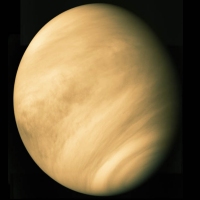Venus
 |
Origin of name Venus is named after the goddess of love by the Romans who considered it to be the brightest and most beautiful planet.
Naming convention
ESA Mission |
Venus Express
Venus Express is ESA's first mission to Earth's nearest planetary neighbour, Venus. In terms of size and mass, Venus is Earth's twin and yet it has evolved in a radically different manner, with a surface temperature of up to 480 °C and a mixture of noxious gases for an atmosphere. Venus Express will make unique studies of the atmosphere and surface.
Physical Properties
| Property | Unit | Value | Earth = 1 |
| Equatorial radius | km | 6051.8 | 0.949 |
| Polar radius | km | 6051.8 | 0.952 |
| Flattening | 0.000 | 0.0 | |
| Mass (x1024) | kg | 4.8685 | 0.815 |
| Volume (x1010) | km3 | 92.843 | 0.857 |
| Mean density | kgm-3 | 5243 | 0.951 |
| Surface gravity at equator | ms-2 | 8.87 | 0.905 |
| Escape velocity | kms-1 | 10.36 | 0.926 |
| Magnetic dipole field at equator | T | < 10-9 |
Orbital Parameters
| Property | Unit | Value |
| Perihelion (x106) | km | 107.48 |
| Aphelion (x106) | km | 108.94 |
| Mean distance from the Sun (x106) | km | 108.21 |
| Mean distance from the Sun | AU | 0.723 |
| Eccentricity | 0.0067 | |
| Sidereal orbit period | d | 224.70 |
| Sidereal rotation period | d | R 243.02 |
| Length of day | d | 116.75 |
| Orbit inclination to Ecliptic | ° | 3.39 |
| Mean orbital velocity | kms-1 | 35.02 |
| Maximum orbital velocity | kms-1 | 35.26 |
| Minimum orbital velocity | kms-1 | 34.79 |
| Axial tilt | ° | 177.36 |
Notes
-
Sidereal orbit period
The time taken by the planet to complete exactly one orbit around the Sun with respect to the celestial sphere. -
Sidereal rotation period
The time in which the planet rotates around its axis exactly 360° with respect to the celestial sphere. -
Length of a day
Defined as the time between two successive sunrises over the meridian. -
Magnetic dipole moment
Calculated as the ratio of the magnetic field strength at the equator divided by the cube of the equatorial radius.
Last Update: 1 September 2019
